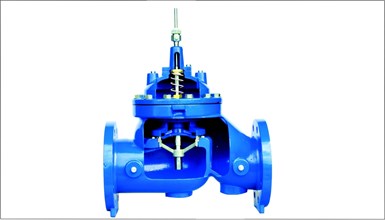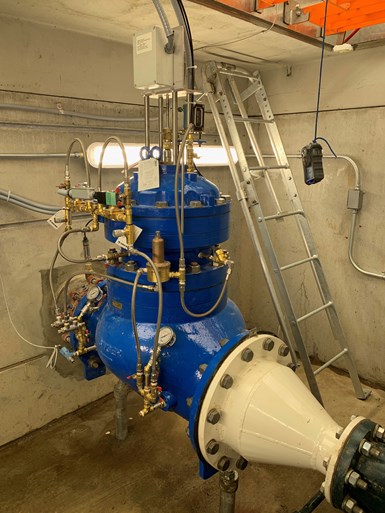CASE STUDY: Water Utilities Can Better Manage Flow Fluctuations with Single Rolling Diaphragm Valves
Without proper pressure management, high-pressure incidents can occur when pumps are turning on or off or when a valve suddenly closes, sending water hammer back through a piping system. Having the right valves to manage large fluctuations in water flow is one way that utilities can balance erratic flows and stay ahead of evolving community demands.
#water-wastewater
It’s not unusual for water utilities to expand infrastructure to address predictable population growth, but there are more factors today that are causing unexpected population changes. Many people have moved as a result of switching to working from home due to the global pandemic, and with more extreme weather events, communities can quickly shrink and conversely, rapidly expand. When this happens, water operators are often faced with new peak and off-peak periods, and demand for water can change quickly, making it more challenging to control a water distribution system’s pressure.
UPGRADING PRV STATIONS TO BALANCE SYSTEM PRESSURE
A west coast utility decided to change all the pressure reducing valves (PRVs) in their water distribution system that was predominantly monitored and

Single rolling diaphragm valve
controlled based on flow demands. With numerous line connections and pressure zones, coupled with a growing population, the fluctuating demand was putting unnecessary over pressure on the distribution system. One of the problems that needed addressing was when a downstream high-pressure event occurred, the seat of the main valve of the old flat diaphragm valves would chatter. This wear and tear resulted in the need for more maintenance to monitor and replace the valve seats in order to avoid a valve failure.
The five-year PRV upgrade was designed to address the fluctuations and ensure redundant pressure and flow control through SCADA automation. By moving to Singer PRVs with redundant pressure control (PR-SM) and single rolling diaphragm (SRD) technology, the new system was designed to provide smooth, steady and precise pressure control from maximum to virtually zero flow, without the need for low-flow bypass valves.
The effective area of the SRD remains constant, so the bonnet is much smaller and lighter than a flat diaphragm version. A measured quantity of water in the bonnet control chamber always gives the same smooth movement of the inner valve (diaphragm assembly) through the entire stroke. By eliminating the seat chatter at low flows, the SRD avoids injecting small pressure pulses into the piping, which, over time, may increase leakage, losses, or pipe bursts. Eliminating the seat chatter with the SRD technology means the new Singer valves are much quieter.
MAINTAINING PRESSURE WITH REDUNDANT BACKUP
The new valves were fitted with electronic primary control with a hydraulic pressure reducing back-up on the loss of power, or failure of the pilot system. Typically, the City pulsed solenoids based on a flow meter to provide a constant flow rate from each PRV. The hydraulic pilot and secondary chamber operate independently of the main electronic control chamber so that if there is a failure, it can override the main valve body and maintain downstream pressures. In the event of a failure, there is now also a limit switch on top of the valve that sends an alarm to the city, so they know that they are running in backup mode. The new backup system was engineered to be used anywhere that valve failure is unacceptable.

The valve runs electronically using the two solenoids seen on the front of the valve to chase a flow rate that is given by the insertion meter that is installed on the reverse side.
ADDING INLINE FLOW METERS TO CONTROL VALVES VIA SCADA
Sites that did not have inline flow meters were fitted with the Singer SPI-MV, a Single Point Insertion electromagnetic flow meter that provides accurate flow data within 2% of actual reading. These flow sensors come pre-calibrated from McCrometer’s NIST traceable calibration lab, so they require no recalibration in the field. With a single-piece design and no moving parts, the electromagnetic sensor contains nothing to wear or break, and is generally immune to clogging by debris. The SPI-MV can also tie back into the existing SCADA system for complete flow-based valve control.
SPECIFICATIONS TO MEET INDIVIDUAL NEEDS
Each valve replacement was uniquely specified. Depending on the consequence of failure, the redundant valve body was either selected or not. If power was available in the vault, the City was also able to add transmitters to the pilotry and valve stem so that the percentage open was available through SCADA along with real-time pressures and flows. The redundant valve body was also provided with a limit switch on a battery power supply so that the city can now receive an alarm as soon as there is a main chamber failure.
IN CONCLUSION
Managing fluctuations in water pressure, regardless of the cause, allows utilities to provide the right amount of water when it is needed. Optimizing the hydraulic integrity of a water distribution system is also one of the most beneficial ways to extend the life of assets. With less maintenance required on the new PRVs and less possibility for failure, the City is confident it can continue to supply a steady flow of water, regardless of fluctuating demand and evolving size of the population.
ABOUT THE AUTHOR
Mike Uthe, based out of Belgrade, MT, is the Northwest manager for Mueller’s technology division. With Mike’s technical expertise and engineering background, he helps utilities with asset management, automatic control valves and pipeline monitoring.
RELATED CONTENT
-
The Pulp and Paper Industry
The pulp & paper industry has seen tough times, but the business will still be around for many decades; the product is too much in demand.
-
The Limits of Standard Manual Globe Valves for Throttling
A common practice in process services is to use manual globe valves with hand wheels for regulating flow.
-
Testing of Hydrogen Valves
Valves are used to control all types of fluids, and while some are easy to manage, others can be a challenge. At the top of the challenging list sits hydrogen, the smallest, lightest molecule known to man.







 Unloading large gate valve.jpg;maxWidth=214)


